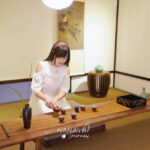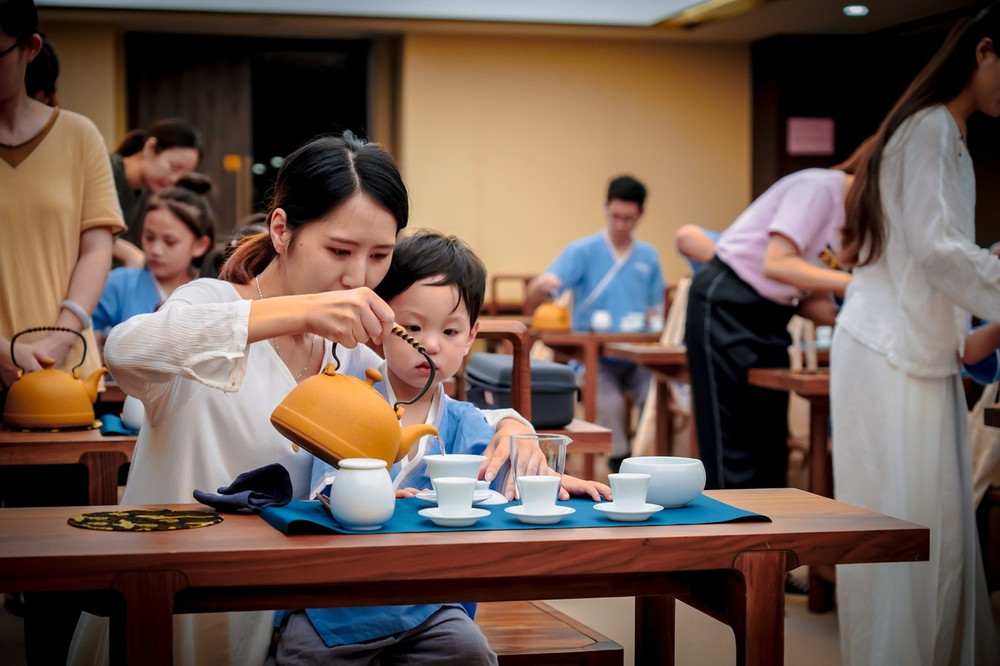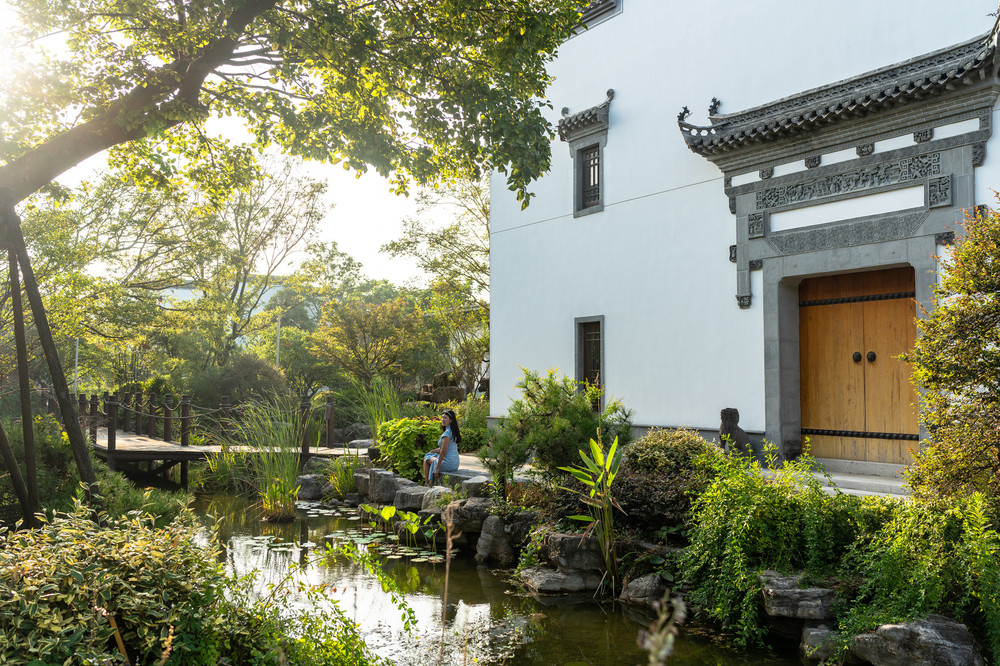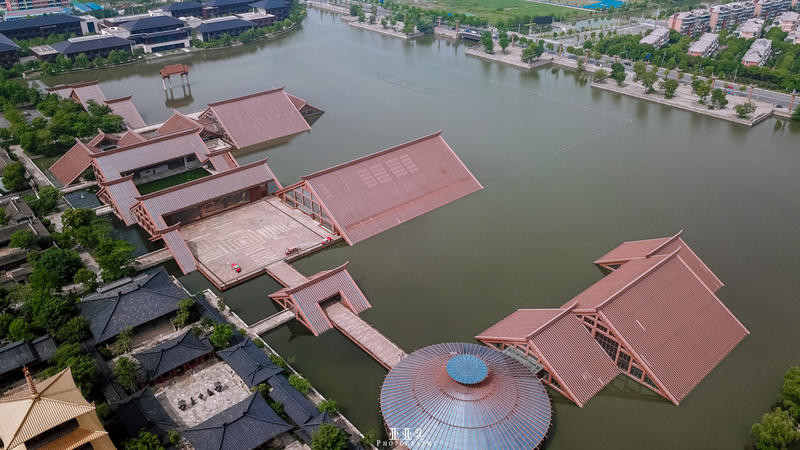Duration: 1 day
Time: January
Companions: Spouses
Activities: Self-driving, Cultural, Freestyle, Hiking, Budget Travel, Weekend Trip
Published on 2022-04-29 22:04
Location: Jade Gallery of Shanghai Museum

Han Dynasty jade, based on the foundation of Warring States jade, saw even greater development.
Besides divine animals, the Western Han Dynasty was also popular for cloud patterns, rush patterns, and nipple patterns.
The scale of jade used by the upper nobility for burial exceeded that of previous dynasties.
Jade cicadas are common in burial jade, with a more vigorous carving.
The Western Han Dynasty’s dragon pattern decorations and dragon pattern butterfly-shaped pendants are beautiful, with the jade color showing a reddish-brown due to the color penetration, plus a bird in the middle, white jade color, and exquisite carving, truly beautiful.
The Western Han Dynasty’s offering food carving is a full-length image, possibly for funeral use, or possibly for blessings.
This jade figure holds a container in hand, making an offering gesture.
The Eastern Han Dynasty’s jade quality is as true as coagulated fat, with a very warm luster, and from the image, it can be roughly seen that there are one male and one female.
Their clothing is different, and their hair ornaments are also different.
The male jade figure obviously wears a hat and has some foreign style, while the female jade figure has a coiled bun.
The Eastern Han Dynasty’s four spiritual pattern jade is pure white, which is similar to the quality of Hetian jade today.
The jade is carved with a phoenix on the top center, Xuanwu below, and both ends look like a victory shape from the side, with the green dragon and white tiger engraved on the outer sides.
Now the four divine beasts are complete.
The four divine beasts represent the four directions of east, west, south, and north.
The ancients believed they had the effect of exorcising evil spirits and praying for blessings.
There are eight seal script characters carved on the partition column: ‘May the descendants live long and prosper, and may they live for ten thousand years,’ expressing a very good meaning.
During the Wei, Jin, Southern and Northern Dynasties, due to political division, frequent wars, and transportation blockage, the source of jade from the Western Regions was limited, and jade products became much less.
Compared with the Eastern Han Dynasty, there seems to be not much progress in craftsmanship.
For example, comparing the dragon rings of the Eastern Han Dynasty and the Western Jin Dynasty, I even think that the craftsmanship of the Eastern Han Dynasty is more exquisite.
After the Tang and Song dynasties, jade gradually developed towards the direction of folk and secularization.
A large number of daily life utensils and ornaments emerged, and the style became more diversified.
The themes of animals, birds, flowers, and forests were very popular.During the Han Dynasty, jade artifacts saw significant development based on those from the Warring States period. In addition to divine and spiritual animals, patterns such as cloud, pu, and ru ding patterns were popular during the Western Han Dynasty. The scale of jade used by the upper-class nobility for burial exceeded that of previous dynasties. Jade cicadas were common in burial jade, and their carvings appeared more vigorous. The pan-chi decorations and pan-chi patterned jade pendants from the Western Han Dynasty were beautiful. Due to the color penetration, the jade color exhibited a reddish-brown hue, coupled with a white jade bird in the middle, the exquisite carvings truly beautiful. The jade figure from the Western Han Dynasty, carved in full length, may have been used for funeral purposes or for blessings. This jade figure holds a container in its hands, presenting an offering of food. The jade figures from the Eastern Han Dynasty, with a texture as smooth as congealed fat, had a very moist luster. From the image, it can be roughly seen that there are one male and one female figure. Their clothing and headdresses are different. The male jade figure is clearly wearing a hat and has some exotic charm, while the female figure has a coiled bun. The ‘Four Spirits’ jade from the Eastern Han Dynasty has a white jade texture, similar to the jade quality of Hetian today. The central upper part of the jade is carved with a Vermilion Bird, while the lower part is carved with a Black Tortoise. From the side, both ends have the shape of a victory, with the sides carved with the Azure Dragon and the White Tiger. Now the four spiritual beasts are complete. The four spiritual beasts represent the four directions of east, west, south, and north. The ancients believed that they had the effect of exorcising evil spirits and avoiding disasters, as well as blessing. On the partition column, there is a shallow carving of eight-character seal script: ‘May the descendants thrive for a long time, and may the lifespan last ten thousand years’, expressing a very good meaning.
During the Wei, Jin, and the Northern and Southern Dynasties, due to political division, frequent wars, and blocked transportation, the source of jade materials from the Western Regions was limited, resulting in fewer jade products. In terms of craftsmanship, it seems that there was not much progress. For example, comparing the pan-chi rings from the Eastern Han Dynasty and the Western Jin Dynasty, I actually think that the craftsmanship of the Eastern Han Dynasty is more exquisite.
After the Tang and Song Dynasties, jade gradually developed towards civil and secular directions, and a large number of daily utensils and ornaments emerged. The style also became more diversified, with animal, bird, flower, and forest themes becoming very popular. The figure of the juggler on the jade belt plate of the Tang Dynasty reflects the influence of cultural exchange between China and foreign countries. The jade decorations of flowers and birds and the jade child holding a lotus from the Song Dynasty all have a fresh life atmosphere and a prominent style of the times. During the Tang and Song dynasties, there were regulations that only officials of the third rank and above could wear gold and jade belts. By the Ming Dynasty, the regulations were stricter, and only officials of the first rank and above could wear jade belts, which shows that jade belts were also a symbol of status to some extent. The front of this jade belt is carved with the image of a minority music player, who dances or plays musical instruments, with smooth facial details and clothing fold lines. The back of the belt plate is plain, with a cow’s nostril at each corner. Especially the Tang flute music belt and the horn and drum music belt have a very novel and interesting image, very vivid. The carving technique is very skilled, which shows that the jade carving technique of the Tang Dynasty was already quite superb. The Flying Apsaras work is truly beautiful, the whole image is the image of a flying apsaras, with a very elegant posture, and the jade is also white and delicate. The flying apsaras fairy looks forward with both eyes, with high buns, arms stretched forward, legs crossed, arms holding beads, and waist bound with long skirts, very dynamic.
Duration: 1 day, Time: January, With whom: Spouse, Activities: Self-driving, Cultural, Free and easy, Hiking, Budget travel, Weekend getaway, Published on 2022-04-29 22:04, Travel location: Jade Gallery of Shanghai Museum.The jade belt of the Tang Dynasty was composed of twelve belt plates, with an additional copper belt buckle. During the Tang and Song Dynasties, regulations stipulated that only officials of the third rank and above could wear gold and jade belts. In the Ming Dynasty, the regulations became stricter, and only officials of the first rank and above could wear jade belts. It is evident that the jade belt also served as a symbol of identity to a certain extent.
The front of this jade belt is intricately carved with images of minority musicians, either dancing or playing musical instruments, with smooth facial details and clothing folds. The back of the belt is plain, with a bull’s nose at each corner. Notably, the Tang flute musician belt and the horn-blowing and drum-striking musician belt feature very innovative and interesting images, vividly portrayed. The carving skills are very refined, indicating that the jade carving techniques of the Tang Dynasty were already highly advanced. The ‘Flying Apsaras’ piece is truly beautiful, with the entire image resembling a flying figure, very elegant in posture, and the jade is white and delicate. The flying fairy looks forward with her eyes, has high coiled hair, stretches her arms forward, crosses her legs, holds a beaded necklace in her arms, and wears a long skirt around her waist, very dynamic. Below is a clover-shaped cloud, with a curled surface, full of three-dimensionality.
The Yunlong patterned sunflower dish is made of white jade, with an open mouth and flat bottom, shaped like a twelve-petaled sunflower. The outer wall is relief-carved with a pattern of two dragons playing with a pearl, one dragon looking forward and the other looking back, with a treasure pearl between the two dragons, which is a more traditional two-dragon pattern. The dragon pattern ring is made of white jade, with a flat image, a hole in the middle, and a dragon pattern on the front, which is a typical image of dragons in the Tang Dynasty, almost the same as dragons in later generations. The scales are arranged in a fine net-like pattern. There is a treasure pearl between the head and tail, which seems to be burning with flames. The back is carved with four equally spaced clouds in the shape of Ruyi, and the whole piece is very delicate.
Song Dynasty jade carvings are delicate and three-dimensional, whether it is turtle and crane patterns, grape patterns, or flower patterns, in addition to the delicate jade quality, the jade color also has a layered change. Liao and Jin Dynasty northern nomadic jade carvings were influenced by the Tang and Song Dynasties, while retaining their own ethnic characteristics, such as spring water and autumn mountain jade decorations. The Spring Water Jade of the Jin Dynasty, through the different colors of the jade itself, carves the scene of the fierce black Sea East Qing hunting the white swan, with clear black and white colors, and the image is lifelike, reflecting the scene of the Liao Dynasty emperor and nobles hunting in spring. The Autumn Mountain Furnace Top is also a work of the Jin Dynasty, using the yellow skin of the jade itself to represent the deep yellow of autumn leaves. In the forest, there are two deer, one looking back and the other drinking water with its neck bent down, very peaceful and serene.
During the Yuan, Ming, and Qing Dynasties, the commodity economy flourished, and the socialization of jade and the scale of the carving industry continued to deepen and expand. The royal family used jade extensively, including daily use, ornaments, furnishings, and various types and quantities of jade articles, surpassing any previous period. The use of jade among the people was also very common, and people from all social strata, including rich merchants and literati, loved jade. The craftsmen of the Yuan Dynasty were good at deep carving techniques, while those of the Ming Dynasty showed a rough style, and those of the Qing Dynasty were more intricate and delicate. This is also an interesting phenomenon; the Yuan and Qing Dynasties were minority regimes, but it was the Han regime of the Ming Dynasty that had the most robust jade style.
The Yuan Dynasty’s lotus and egret patterned stove top is shaped like a steamed bun, with an oval and flaky base. It employs a multi-layered carving technique. Two egrets are depicted among lotus leaves and aquatic plants, either bending their necks to forage for food or looking back, displaying a vivid and expressive demeanor. The lotus and egret pattern symbolizes ‘continuous success in examinations,’ which is naturally most needed by scholars. Isn’t learning a set of good skills just to be sold to the imperial court? The Qianlong period’s triple dragon patterned gu was a work made to imitate bronze drinking vessels using Hetian yellow jade, used for flower arrangements. The middle part features three dragons in relief carving, exquisitely crafted, likely a royal item, representing the pinnacle of jade-making technology in the Qing Dynasty.The inlaid treasure octagonal jade box is made of white jade. Its outer walls are outlined with gold threads into floral and branch patterns and further adorned with red stone and mending gems, making the petals and leaves quite ornate. This style carries a touch of exotic flair and has a very bright overall color.
The Qing Dynasty’s landscape and figure mountain child depicts the ‘Nine Elders’, a scene of Bai Juyi and eight other elders touring Luoyang’s Fragrant Mountain. The distribution of figures and the image of ancient trees have a strong sense of depth, with exquisite carving and beautiful layout.
The lotus-style water village has a thick texture, delicate carving, and vivid images of lotus and egrets. The water container, also known as a water pot, is a vessel for holding water in the study room. Such stationery appeared more frequently after the Song Dynasty and reached its peak in the Ming and Qing Dynasties.
The fisherman is a decorative piece. One hand holds a fish, the other a money basket. The hat on his head and the raincoat on his back retain the original color of the jade skin. The fisherman’s facial features are very three-dimensional and meticulously depicted.
The figure and landscape patterned incense holder is incredibly delicate. If unfolded, it would be a beautiful landscape painting! In the picturesque scenery, even the figures are carved with great detail.
The dragon patterned jade wash is a truly beautiful piece of art. With ink green interspersed on a white ground, the entire vessel presents a begonia shape. Four dragons climb and look out in relief along the rim. One dragon spouts a water column, and the beads in the water coincidentally are the emerald green color of the jade, which is both aesthetically pleasing and full of interest.
The figure patterned peach-shaped cup is also extraordinary. Despite being just a cup, it is carved with very intricate patterns. The quality of the jade may be questionable, but the craftsmanship is undoubtedly top-notch.









